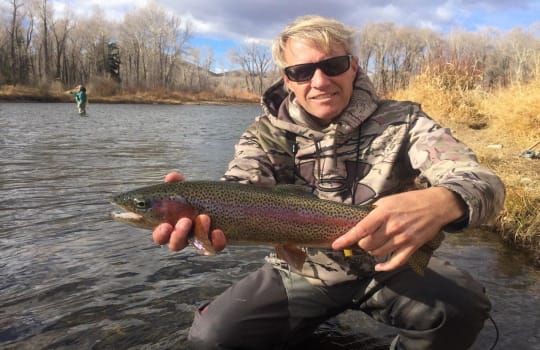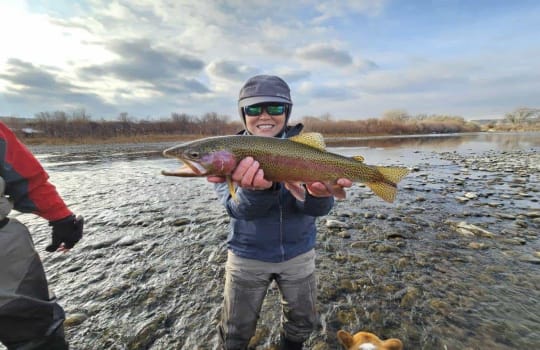by Ron Pecore, 5280 Angler Fly Fishing Guide
Traveling to new water is one of the great joys of the fly fishing lifestyle. However, along with excitement, approaching unfamiliar water can create some unease. There are a few simple things I do when traveling that are fundamental to early success. Fundamentally, it’s about trusting my own bank of experiences, and drawing connections between the old and the new. Though each of us have our own unique wells of fly fishing experiences from which to tap, those backgrounds are our most valuable resources we have when approaching a brand new trout stream. Though specific bug life, flows, scenery, temperatures, and more will all vary, the basics of successful trout fishing hold true from watershed to watershed.
Trout generally will be found in certain places in the river where the current will not only bring them food, but the structure of the river bottom or seams in that current also allow them to to expend the least amount of energy. These ideal river positions will similar, no matter where you go. Find the fish – catch the fish.
The angler that learns this simple trick will catch fish no matter where they travel. She or he will examine the new water first and foremost looking for the feeding lies. As the size of the river increases, look for both the bigger, broader versions of these feeding lies, but also look for the lie within the lie. Draw upon previous experiences, where you found feeding fish. Look at the new water through that lens, and you will find the trout.
Recently 5280 Angler guides headed West on our annual spring guide trip. We all went to the Gunnison River, and a few of us hit the  Eagle River on our way home. I had never fished the Gunnison or the Eagle, so I just stuck to basic fundamentals of knowing where I should find trout. I targeted the spots that appeared most similar to places I’ve found feeding fish in the past. A few weight adjustments, and I was into fish – consistently. In both rivers I used my go to searching rig of a #12 rubbers leg stone a tan worm and a #18 bronze jailbird midge emerger. As you can see from our pictures Tony Ramos (one of our new guides for 2018), and I had stellar days.
Eagle River on our way home. I had never fished the Gunnison or the Eagle, so I just stuck to basic fundamentals of knowing where I should find trout. I targeted the spots that appeared most similar to places I’ve found feeding fish in the past. A few weight adjustments, and I was into fish – consistently. In both rivers I used my go to searching rig of a #12 rubbers leg stone a tan worm and a #18 bronze jailbird midge emerger. As you can see from our pictures Tony Ramos (one of our new guides for 2018), and I had stellar days.
 Eagle River on our way home. I had never fished the Gunnison or the Eagle, so I just stuck to basic fundamentals of knowing where I should find trout. I targeted the spots that appeared most similar to places I’ve found feeding fish in the past. A few weight adjustments, and I was into fish – consistently. In both rivers I used my go to searching rig of a #12 rubbers leg stone a tan worm and a #18 bronze jailbird midge emerger. As you can see from our pictures Tony Ramos (one of our new guides for 2018), and I had stellar days.
Eagle River on our way home. I had never fished the Gunnison or the Eagle, so I just stuck to basic fundamentals of knowing where I should find trout. I targeted the spots that appeared most similar to places I’ve found feeding fish in the past. A few weight adjustments, and I was into fish – consistently. In both rivers I used my go to searching rig of a #12 rubbers leg stone a tan worm and a #18 bronze jailbird midge emerger. As you can see from our pictures Tony Ramos (one of our new guides for 2018), and I had stellar days.Some anglers will fish the same water, the same seasons, over and again as there is comfort and security in repeated success. I encourage you to seek out new water. When doing so, don’t forget all the reasons behind your success on the familiar water. Instead carry that knowledge with you on your new adventure. You’ll very quickly feel more comfortable, using that former success as criteria for decision making when looking at that unknown stream. Soon, you’ll be craving new water, and relishing successful adventure.
Where an unknown stretch of water may once have brought trepidation, you’ll relish the sight of “juicy water.”
Reading water is something I learned in my early days of fly fishing while chasing trout along highly pressured waters of Pennsylvania streams. Moving West years ago, I used what I learned and applied it to the technical trout streams of the Front Range and beyond.
Though the aesthetics of trout streams offer wonderful diversity, the fundamental structure and current patterns aren’t all that different from place to place. Take the tricks you’ve learned along your home water with you on your next fly fishing trip, and trust that they will serve you well.
If you would like to spend a day on the water with guide Ron Pecore or any one of our trusted professional guides, CONTACT US today to book your 5280 Angler Guided Fly Fishing Trip.








